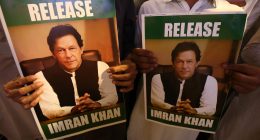Unlock the Editor’s Digest for free
How many people make for a good debate? The closer we get to the expected timing of a first US interest rate cut, the hotter a topic it becomes — and the more individuals weigh in. Ten of the Federal Reserve’s 12 rate-setting voters have managed at least 20 public appearances between them in the past fortnight.
That has given market watchers plenty of commentary to parse, even if market direction suggests no more certainty about the Fed’s policy path than before the volume of chatter began to rise. If anything, there is greater sensitivity. On Thursday, the S&P 500 reversed a boosterish 0.8 per cent morning gain to close 1.2 per cent lower — its worst day in eight weeks. The tumble was not due solely to interest rate jitters, but it did not help that oil prices hit a five-month high, breaking through $90, at about the same time Minneapolis Fed head Neel Kashkari said he would question the need for any rate cuts at all if inflation didn’t ease further.
Kashkari is not even a voting member of the Fed’s rate-setting committee this year — regional Fed presidents rotate those positions — but his comments were close to those of some colleagues with a greater say in the deliberations.
All the talk and uncertainty is not making life in the markets easy. Back in December, investors could happily look ahead to a series of cuts beginning in the (then) far-distant summer. At that point, the scale of monetary easing — whether the six cuts of a quarter of a percentage point each priced in by investors, or the three then and currently projected by the Fed — mattered less because momentum was based on general relief that rates had peaked. Now the precise timing and scale of any easing have become much more important.
From Fed speakers, the range of comments in the past two weeks have been roughly bookended on the hawkish side by Atlanta Fed president Raphael Bostic and Fed governor Christopher Waller, and on the more moderate side by Cleveland Fed president Loretta Mester, who has a reputation as a hawk but who this week did not rule out a June rate cut.
Bostic, typically considered more dovish, told CNBC he thought it more appropriate to consider cutting rates towards the end of the year while Waller, one of the most influential rate-setters, said last week that the Fed should be in no rush to ease policy. Sitting in the middle, along with many hapless investors, is Fed chair Jay Powell, who said this week that the Fed’s inflation battle was “not done” and that the central bank had time to wait for fresh economic data.
He is right, but it does not make investor decisions any easier. Fed funds futures imply two quarter-point cuts by year-end, with a still fair chance of a third. But that is best thought of as the median of a far broader range of market thinking.
Citigroup’s economists, for example, have been forecasting five quarter-point cuts while those from Vanguard reckon the Fed could see out 2024 with no change. “Our base case scenario for this year includes a significant rise in the unemployment rate and two quarters of negative growth — that is, a recession,” said Andrew Hollenhorst, economist at Citi. “We think the weaker activity will have the Fed cutting rates a quarter-point at every meeting starting in June.”
From Vanguard’s Qian Wang: “We look at the economy and we see potentially a scenario where you have inflation remain very sticky and above target — and you also have above-target growth. In this case we don’t think that the Fed can claim ‘mission accomplished’.”
Investors also have November’s US presidential election to consider. Ask Fed officials and they say politics do not play a role. But look at its actions over the past 30 years, and election years are, in fact, different.
On average, the US rate-setters have held steady at 71 per cent of their election-year meetings, against 67 per cent in other years, according to Bespoke Investment Group’s count. Narrow it to the more politically charged period between May and November, and that rises to 81 per cent versus 65 per cent. In presidential election years, the Fed has cut rates at just 3 per cent of its meetings over those months, compared with 14 per cent in other years. “As the pages of the calendar turn it raises the question: will the rate cuts that keep getting pushed further out on the horizon ever arrive?” the group’s strategists asked.
Bumper jobs figures on Friday, with an unemployment rate of 3.8 per cent, only added to the risk that those expecting swift and deep action from the Fed may be disappointed.
Powell set markets on this uncertain path last August when he described the Fed as “navigating by the stars under cloudy skies”. Investors have shown a lot of faith so far in its ability to chart the best course. But, to mix travel metaphors, the rubber is getting closer to hitting the road. If the Fed is not clearer soon about its direction — and the data may not allow it to be — then this year’s stock market rally could soon begin to lose its way.
jennifer.hughes@ft.com
Also Read More: World News | Entertainment News | Celebrity News









